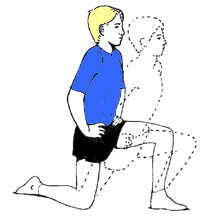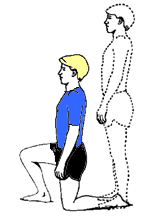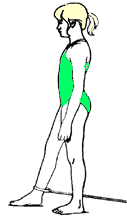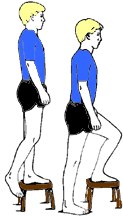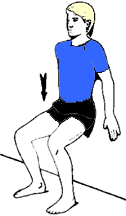Although there is a substantial amount of overlap, the rehabilitation process can be divided into three distinct phases: acute, recovery, and functional.1 A comprehensive rehabilitation plan will include different types of exercises that are tailored for each of the three healing phases.
Acute Phase
Immediately after an injury occurs, there will be variable amounts of pain, swelling, weakness, muscle fatigue, limited range of motion, joint locking or instability, and decreased sports performance. The pain and swelling are indicators of inflammation due to tissue damage, and require immediate attention. Minimizing additional tissue damage is an important goal of care during the first phase. Therefore, protection of injured areas and the surrounding healthy tissue is paramount. Frequent cooling of the damaged tissue will limit bleeding and swelling, and help control pain.
Once the inflammation has begun to subside and the pain is under control, controlled passive or active exercises should be initiated to prevent atrophy and start retraining. Since isometric training results in muscle strength gains mainly at the joint angle used,2 controlled motion (dynamic) exercises in a pain-free range can be initiated as soon as they can be tolerated. Initially, only a minimal external load (such as exercise tubing with some slack) should be used. This can be carefully progressed, based on the tolerance and pain levels of the athlete. Electrical stimulation electrotherapy can improve motor unit recruitment in this stage, while helping control excessive pain.3
Recovery Phase
Since return to sport activities is generally ill-advised without full range of motion, exercises to regain normal joint flexibility are crucial in the early recovery stage. To be effective, stretching exercises may need to be performed two or three times a day, with a minimum of three repetitions of approximately 30 to 60 seconds for each muscle group. Stretching and/or proprioceptive neuromuscular facilitation (PNF) can be performed after the involved tissues have been heated above resting body temperature, either following an active warm-up or by passive, external heating (such as a hot tub or heating pad).
Daily dynamic resistance exercises to increase strength should be started as soon as they can be tolerated, in order to avoid atrophy and ensure a rapid return to sport activities. Both the concentric and eccentric muscle actions should be worked, with gradually increasing resistance and range of motion.4 Closed kinetic chain exercises (the distal segment is fixed) provide for more activation of the co-contractors and stabilizer muscle groups, and are frequently recommended over open kinetic chain exercises.5 Muscle endurance must be addressed by stimulating a higher level of oxygen uptake for a sustained effort, in order to prevent deconditioning. Elastic exercise tubing has been found to be a safe and effective method of providing progressive resistance exercises with an aerobic component.6
Functional Phase
This important phase prepares the injured athlete to return to regular training sessions and competition. The exercises now become more functionally oriented, to simulate the demands of the patient's sport. For example, figures 1-6 (From Outcomes Assessment 2004, available through FCER) demonstrate an effective lunge pattern of preparatory functional exercises. Then, "sport-specific training" incorporates movements and activities that train and coordinate the specific muscle actions and reactions needed for the athlete's sports performance.
At this point, a good understanding of the metabolic and neuromuscular demands of the sport is helpful, so that specific muscle activation patterns can be trained.7 The functional phase focuses on the rehabilitation and conditioning of the entire kinetic chain, and may need to progress into specialized training for explosive strength, such as plyometrics.
Conclusion
Physical rehabilitation should be planned so as to take place simultaneously with the biological healing of the injured tissues. Current rehabilitation concepts now emphasize functional activities and retraining of normal loading and movement patterns. Appropriate and progressive rehab programs should be initiated early in the treatment of all patients with sports or exercise injuries. Elastic tubing strength retraining programs comprised of simple, isotonic resistance techniques are readily available, none of which require expensive equipment or great time commitment. This allows the doctor of chiropractic to provide cost-efficient, yet very effective and sport-specific rehabilitation care.
References
- Frontera WR. Exercise and musculoskeletal rehabilitation; restoring optimal form and function. Phys SportsMed 2003;31:39-46.
- Lindh M. Increase of muscle strength from isometric quadriceps exercises at different knee angles. Scand J Rehabil Med 1979;11:33-6.
- Snyder-Mackler L, Delitto A, Bailey SL, et al. Strength of the quadriceps femoris muscle and functional recovery after reconstruction of the anterior cruciate ligament: a prospective, randomized clinical trial of electrical stimulation. J Bone Joint Surg Am 1995;1166-73.
- Dudley GA, Tesch PA, Miller BJ, et al. Importance of eccentric actions in performance adaptations to resistance training. Aviat Space Environ Med 1991;62:543-550.
- Escamilla RG, Fleisig GS, Zheng N, et al. Biomechanics of the knee during closed kinetic chain and open kinetic chain exercises. Med Sci Sports Exerc 1998;30:556-569.
- Roy S, Irvin R. Sports Medicine: Prevention, Evaluation, Management, and Rehabilitation. Englewood Cliffs, NJ: Prentice-Hall, 1983:195.
- Kibler WB, Chandler TJ. Sport-specific conditioning. Am J Sports Med 1994;22:424-432.
Kim Christensen, DC, DACRB, CCSP, CSCS
Director, Chiropractic Rehabilitation and Wellness Program
PeaceHealth Hospital
Longview, Washington
Click here for previous articles by Kim Christensen, DC, DACRB, CCSP, CSCS.






